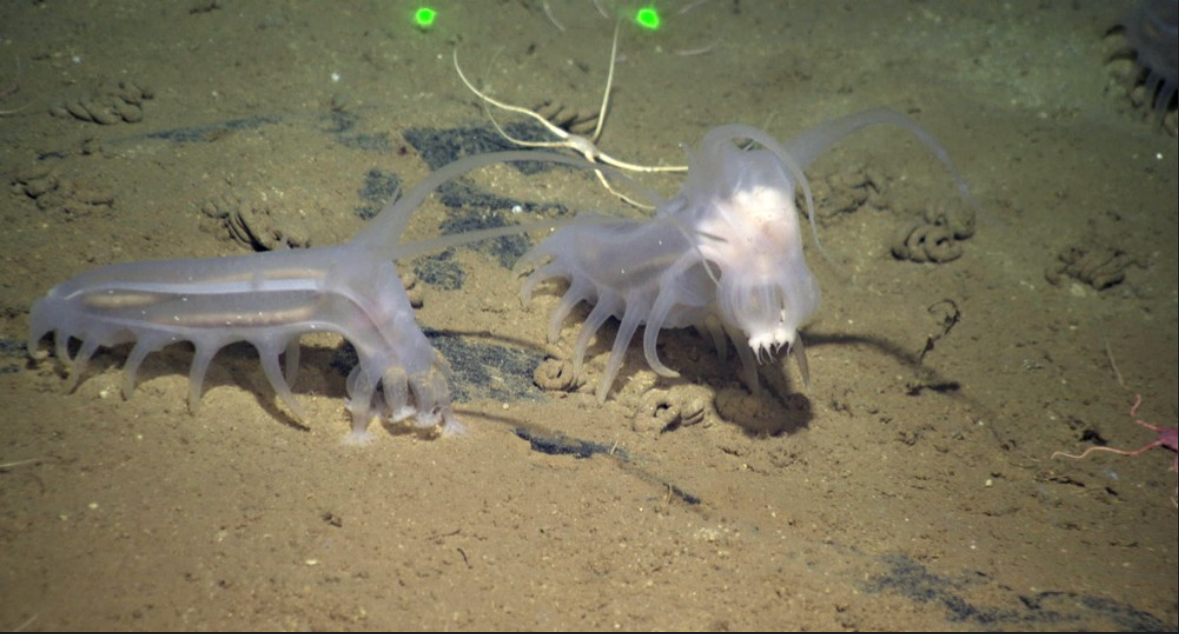Main photo by Ocean Networks Canada

Above photo via MBARI
Sea Pigs (Scotoplanes) are a type of Sea Cucumber
They live in the deep sea, specifically on the abyssal plain up to depths of 5000m
They can grow up to 4-6 inches
They have 6 pairs of enlarged tubal ‘feet’, and use water cavities in their bodies to inflate and deflate them in order to move around, as well as ten buccal tentacles lining their oral cavity

Above photo via Ocean Networks Canada
They live on the sea floor feeding on delicious foods such as decaying animals, poo and mucus!
If they are disturbed they can swim! In fact some Sea Pigs spend most of their lives swimming around in the water column using their frontal and anal lobes to propel themselves around!
They will gather in large numbers around whale corpses to feed and perhaps find a mate

Above, a congregation of Sea Pigs feeding on a whale carcass via MBARI
Their reproductive system is unique, the males only have one testis, and the females one ovary!
Also their skin contains a toxin called holothurin which is poisonous to predators…
They have a poorly defined respiratory system, and have to breathe through their anus!

Above photo by Oceans Network Canada via Treehugger
As they have evolved at deep sea depths they would swell and burst if brought to the surface
They are hosts to several parasitic invertebrates, including snails and small crustaceans
But wait! What’s this…?

Above Above photo via MBARI
What’s that red thing hiding under the Sea Pig?

Above photo via wikipedia
It’s a King Crab!

Above photo via MBARI
Peek-a-boo!

Above photo by Josi Taylor via MBARI
Why do King Crabs ride on Sea Pigs?
Usually King Crabs like to hide in rocks and seaweed from predators, but it is thought that these King Crabs were carried by the ocean current while they were small larvae and ended up in the deep sea…an area devoid of such hiding places!
“It’s like looking for a port in the storm,” said James Barry, ecologist and lead author of the study at the Monterey Bay Aquarium Research Institute (MBARI) in Moss landing. Sea cucumbers are the ports or the biggest buildings to hide next to in an otherwise empty area.” Scientific American

Above, ’ This photograph of the muddy seafloor offshore of Monterey Bay shows three Scotoplanes sea cucumbers, at least two of which are host to juvenile king crabs.’ MBARI
Barry and his team found a total of 600 juvenile crabs, 96 percent of which were either clinging onto sea cucumbers or hanging around right next to them. Sometimes the crabs were upside down holding onto the belly of the sea pig and other times they were crawling on its side. In some cases, the researchers found more than one crab on a sea cucumber. Of the nearly 2,600 sea cucumbers videotaped, 22 percent had at least one juvenile crab clinging to them
Goodbye Sea Pig, and your King Crab jockey!

Above photo via MBARI
edit- I completely forgot to add my sources…wikipedia and MBARI, unless specified

I love the Cambrian Era fossils, so many strange creatures. I’ve not read Wonderful Life mainly because I’d like an up to date version with the newer discoveries and interpretations…
Have you ever checked out the Chinese fossils? They are so well preserved the detail is astonishing, often complete with soft tissues! I managed to score a book from Amazon which was massively reduced because of a bit of damage to it
Just found this which could tick the box for me